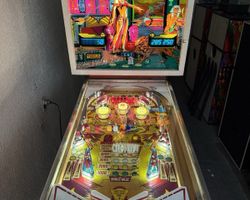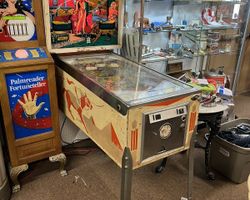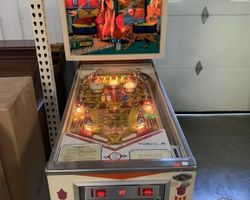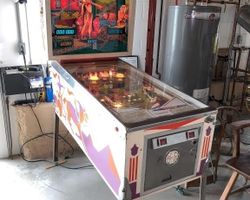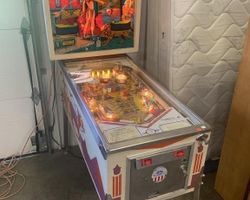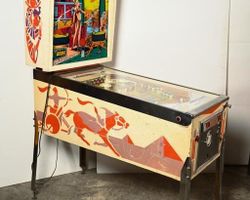Cleopatra
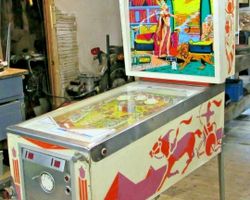
Average Prices: USD $200 to $1,000
Produced: December, 1977
Production Run: 1,600 units
Machine Type: Electro-mechanical
Players: 4
Design by: Ed Krynski
Art by: Gordon Morison
The pinball machine "Cleopatra" from D. Gottlieb & Company stands as a notable electro-mechanical (EM) creation from the late 1970s. Released in December 1977, this four-player machine, bearing model number 409, brought the allure of ancient Egypt to arcades and homes. Its thematic foundation drew directly from the historical figure of Cleopatra, utilizing a visual language of pyramids, hieroglyphs, and pharaonic splendor to immerse players in an anachronistic world of flippers and targets.
The creation of "Cleopatra" was a collaborative effort, with the game's design attributed to Ed Krynski, a name frequently associated with inventive and engaging pinball layouts. Gordon Morison, a prolific artist in the pinball industry, crafted the distinctive artwork that adorned the machine, including its playfield and backglass. Gottlieb produced 1,600 units of "Cleopatra," with 349 designated for domestic distribution (including 70 sample units) and a significant 1,251 units for export. A unique technical detail for "Cleopatra" is its distinction as potentially Gottlieb's first EM game to incorporate DC power for its playfield coils, a feature noted by the inclusion of a VK-448 bridge rectifier in its manual. While "Cleopatra" is a four-player EM machine, Gottlieb also released a two-player EM variant titled "Pyramid" in 1978, and a four-player solid-state (SS) version also named "Cleopatra" in 1977, illustrating the company's approach to leveraging popular themes across different technological platforms.
Signature Features and Design
"Cleopatra" is characterized by a selection of playfield elements that contribute to its fast-paced and engaging gameplay. Key features include two flippers at the base of the playfield, three pop bumpers, and two slingshots designed to propel the ball with vigor. The playfield also incorporates three standup targets and two kick-out holes, offering varied shot opportunities. A central element for scoring is the five-bank drop targets, which reset upon completion, providing a recurring objective for players. Two star rollovers further diversify the scoring paths.
The artwork by Gordon Morison defines the machine's aesthetic. The vivid colors and intricate details of the Egyptian theme are consistently praised, particularly the backglass art, which many consider superior to other machines with similar themes. This visual appeal enhances the overall experience, drawing players into the theme from the moment they approach the machine. The sound package for "Cleopatra" is classic EM, featuring three distinct chimes and a knocker, providing satisfying auditory feedback for key scoring events and replays, which max out at 15 on the replay wheel. These features work in concert to create a cohesive and captivating machine that balances visual appeal with interactive components.
Playfield and Mechanics
The "Cleopatra" playfield layout is a testament to its design philosophy of creating a dynamic and challenging EM experience. At the bottom, the two flippers provide direct control for shot execution. Above them, the playfield opens into a space dominated by the prominent five-bank drop targets, positioned strategically to be accessible yet demanding. Successful clearance of these targets awards points and often triggers other playfield features.
The three pop bumpers are situated to create lively ball action, sending the ball ricocheting unpredictably and often setting up further shot opportunities. The two slingshots positioned above the flippers are crucial for deflecting the ball back into the upper playfield. Two kick-out holes serve as collection points for specific shots, rewarding precision with bonus points or ball-releasing action. Adding to the scoring possibilities are two star rollovers, encouraging players to aim for specific lanes. A notable design element is a tight slot that serves as a return path for the ball to the upper sections of the playfield, demanding accuracy to navigate successfully. Another challenging shot is described as an "almost impossible extra ball shot," which adds a high-risk, high-reward element to the game. The playfield’s design promotes a fluid, high-velocity ball flow, urging players to keep the ball in motion and react swiftly. The artwork is seamlessly integrated into the layout, with hieroglyphs and Egyptian motifs guiding the player’s eye and reinforcing the theme across the entire surface.
Gameplay Dynamics
"Cleopatra" offers a gameplay experience that distinguishes itself through its speed, strategic depth, and the sheer number of objectives available to the player. The game's mechanics, built upon an electro-mechanical foundation, deliver a distinct tactile feel with the audible clunk of relays and the satisfying thud of the knocker. Despite its EM nature, "Cleopatra" plays with a velocity that many describe as akin to a solid-state machine, providing a rapid-fire sequence of shots and reactions.
The core progression often revolves around hitting the five-bank drop targets. Completing this bank is a primary objective, but the risk-reward dynamic comes into play, as attempting to clear them too aggressively can often lead to quick drains. Players must balance the pursuit of these targets with managing ball control and capitalizing on other scoring opportunities. The maximum displayed point score is 199,990 points per player, making high scores a significant achievement.
The game challenges players with a multitude of tasks. Beyond the drop targets, players aim for standup targets, seek to activate star rollovers, and attempt to make the difficult shots into the kick-out holes. The "tight slot" requiring precision to return the ball to the upper playfield and the exceptionally challenging "extra ball shot" compel players to hone their aiming skills. Success in "Cleopatra" requires not only quick reflexes but also strategic planning, deciding when to push for high-value targets and when to play more conservatively to maintain ball control. An end-of-ball bonus system further incentivizes diverse play throughout each ball.
Reception and Legacy
The reception of "Cleopatra" within the pinball community has been consistently positive. Enthusiasts frequently praise its engaging design and thematic execution, with ratings often clustering in the 8.0 to 9.2 range. Its status as a standout electro-mechanical pinball machine is firmly established, serving as an example of D. Gottlieb & Company's design prowess during the EM era.
A significant strength highlighted by players is its fast-paced gameplay. The machine is often described as a "rocket ship," indicating its high velocity and dynamic ball movement, which provides an exhilarating experience uncommon for EM titles of its time. Many note that "Cleopatra" feels more like a solid-state game in its play dynamics, aside from the score reels and pop bumper mechanics. This "SS-like" feel is often cited as a key factor in its enduring appeal.
The design contributions of Ed Krynski are frequently lauded, with "Cleopatra" often cited as another example of his ability to create compelling and enduring layouts. The game's challenging shots, including the tight slot for ball return and the difficult extra ball shot, are seen as positives that add depth and replayability. Players also appreciate the strategic depth offered by the risk/reward nature of the drop targets and the multitude of tasks required for significant scoring. Gordon Morison’s vibrant and beautiful Egyptian-themed artwork, especially the backglass, consistently receives commendation for enhancing the machine's overall appeal. While not flawless, "Cleopatra" has no significant weaknesses that detract from its overall reputation. Its legacy is one of a fast, challenging, and highly engaging EM machine that exemplifies the pinnacle of electro-mechanical design, bridging the gap between traditional EM play and the emerging solid-state era.
Sponsored Links
 Ebay Listings
Ebay Listings
 Auction Results
Auction Results
| Cost | Location | Date |
|---|---|---|
| USD $3,299 |  Pennsylvania, United States Pennsylvania, United States |
08 March, 2025 |
| USD $2,250 |  Ohio, United States Ohio, United States |
05 March, 2025 |
| USD $1,750 |  West Virginia, United States West Virginia, United States |
24 January, 2024 |
| AUD $830 |  Victoria, Australia Victoria, Australia |
15 October, 2023 |
| USD $875 |  Pennsylvania, United States Pennsylvania, United States |
05 September, 2023 |
| USD $450 |  Pennsylvania, United States Pennsylvania, United States |
08 August, 2023 |
| CAD $2,350 |  Canada Canada |
11 April, 2023 |
| EUR €2,590 |  Nordrhein-Westfalen, Germany Nordrhein-Westfalen, Germany |
26 October, 2021 |
| USD $460 |  United States United States |
03 September, 2021 |
| USD $1,725 |  United States United States |
26 June, 2021 |


Private Policy · Search Website · Contact Us
As an eBay Partner, we may earn a commission from qualifying purchases made through links on this site, at no additional cost to you.
All trademarks and copyrighted materials remain property of their respective owners. All other content copyright 2007 - 2025 Pinpedia.

